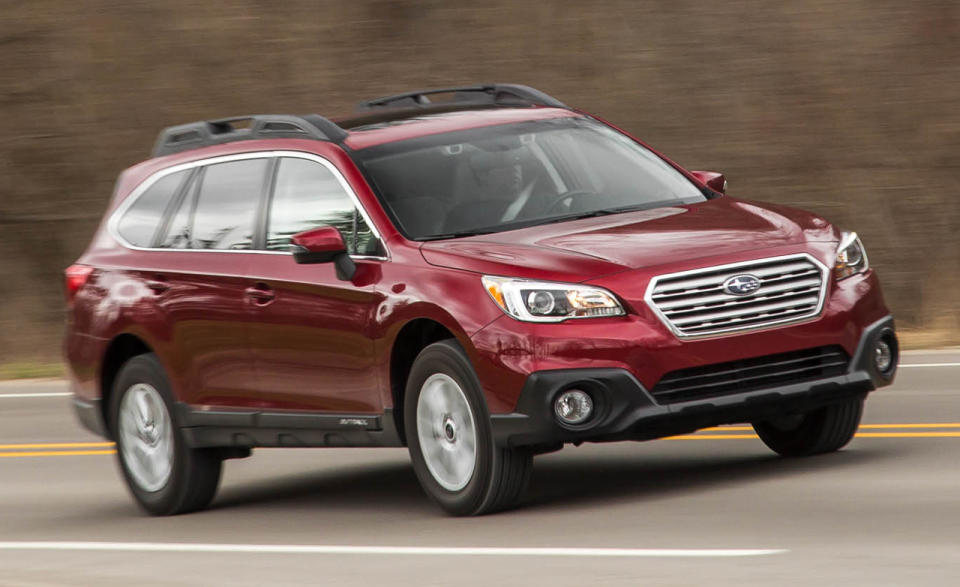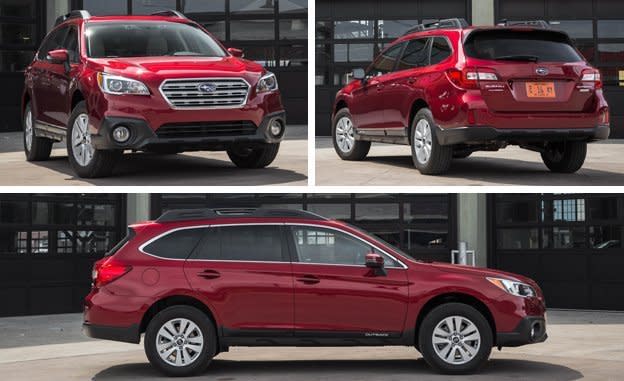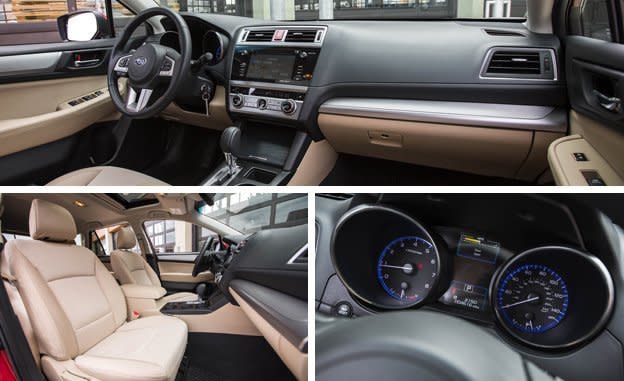2016 Subaru Outback

Overview: The Outback wagon sits atop Subaru’s U.S. lineup and shares underpinnings with the Legacy mid-size sedan. It’s offered in four versions—2.5i, 2.5i Premium, 2.5i Limited, and 3.6R Limited. The first three, powered by a 175-hp 2.5-liter flat-four engine, are by far the most popular. The top engine option, a 256-hp 3.6-liter flat-six, comes only on the 3.6R model. Both engines work through a continuously variable automatic transmission, and, significantly, all-wheel drive is standard across the line. No matter how it is configured, the Outback is an outlier in the marketplace, where traditional station wagons remain rare, with only automakers such as Volvo, Volkswagen, Audi, BMW, and Mercedes-Benz continuing to offer such vehicles. Still, the Outback is a strong seller for Subaru, with 152,294 of them finding new homes last year, which translates to more than 25 percent of the brand’s sales.
What’s New: In our most recent tests of the Outback, it had just been redesigned for the 2015 model year. For 2016, Subaru implemented a rash of minor yet useful updates. The 2.5i Limited and 3.6R Limited models have retuned suspension dampers for a smoother ride. The EyeSight package of driver-assist features, which last year included blind-spot monitoring, lane-departure warning, automatic emergency braking, and adaptive cruise control, now includes a lane-keeping function, meaning that if it senses the driver inadvertently wandering it will do more than sound an alarm: The steering will nudge the car toward the center of its lane. EyeSight is offered as a stand-alone, $1695 option on the Outback 2.5i Premium and in an option package that also includes a sunroof, navigation, and proximity key on Outback 2.5i and 3.6R Limited models. It is a notably comprehensive advanced safety bundle at the Outback’s price point.

Also new for 2016 is a connected-services feature Subaru calls Starlink Safety Plus, which includes SOS emergency assistance via a button above the driver’s head, automatic collision notification for emergency services, and remote vehicle-diagnostic reports. It’s free for the first year of ownership; a subscription is required after that. An enhanced version, dubbed Starlink Safety Plus and Security Plus, adds the ability to remotely lock or unlock the doors, honk the horn and flash the headlights, and locate the car via a phone app (and enables a stolen-vehicle recovery feature). It is also available for a fee.
What We Like: The Outback is a supremely likable vehicle, thanks to its roomy and comfortable interior, huge and usefully shaped 36-cubic-foot cargo hold, and standard all-wheel drive. For more space, the 60/40-split rear seats fold completely flat at the behest of trunk-mounted levers or buttons atop each backrest. Despite its SUV-like plastic exterior trim and enhanced ride height, the Outback drives like the Legacy sedan, with commendably well-controlled body roll, a compliant yet planted ride, and accurate steering. We did sense that Subaru’s tuning work on the electrically assisted steering paid off, with the 2016 model exhibiting more positive-feeling reactions to steering inputs. Even before the update, the Outback’s steering weighted up in a linear fashion and exhibited none of the ill behaviors—stickiness or limp zones, for example—of some other electrically assisted steering systems on the marketplace.
We evaluated a 2.5i Premium model for this review, so we can’t speak to the efficacy of Subaru’s work on the suspension of the Limited models; we can say our Outback rode well, its tall-sidewall tires absorbing Michigan’s post-winter potholes like they were cracks in a sidewalk. Our test model had the EyeSight safety package, which offers nuanced responses to impending calamities. (This is unlike, say, General Motors’ forward-collision warning system, which goes off with a frequency that suggests GM wants to keep reminding owners that they purchased the feature.) We found that the Subaru system intervened appropriately, warning of impending collisions only when we purposefully sped toward stationary or slower-moving vehicles or changed lanes without signaling. (Both the lane-departure and forward-collision warning systems, as well as blind-spot monitoring, can be shut off.) An alternative to this technology, of course, is a driver who’s aware of the surroundings, a task made easier by the Outback’s thin roof pillars and excellent visibility in all directions.

What We Don’t Like: As agreeable as the 2.5i models’ four-cylinder engine and CVT can be in normal driving, the combination leaves drivers wanting in the speed department. Simply put, it’s slow, even though the CVT avoids many of the ills that typically plague transmissions of this type. (There isn’t as much lag or “rubber-band” acceleration effect in the Outback, although we noted the transmission could take longer than expected to fully engage when quickly shifting between drive and reverse.) Driven in a typical fashion, the powertrain is smooth and willing, a demure partner that returns decent fuel economy. (We recorded 25 mpg in our 2015 Outback 2.5i test.) Even the flat-four engine is subdued, with only a muffled thrum penetrating the cabin; it’s enough to let you know the engine is running, nothing more. The six-cylinder 3.6R Limited, which got 22 mpg in our test, is quicker and sounds better.
Otherwise, our other key complaints pertain to the front seats’ aggressive lumbar support and to the navigation system, which disallows anyone from inputting new addresses when the Outback is on the move—you’re only allowed to seek out basic points of interest (gas stations, restaurants, the like) or to choose among previously entered destinations. Overall, though, the Outback is more than qualified for family duty, off-road adventuring, or supporting an active lifestyle with its cargo room and standard roof rails to which any number of attachments can be fitted.
Verdict: Keeping the wagon roaming America’s landscape, which is fine by us.
BUILD YOUR OWN | RANK IN SEGMENT
Specifications >
VEHICLE TYPE: front-engine, 4-wheel-drive, 5-passenger, 4-door hatchback
BASE PRICES: 2.5i, $25,845;
2.5i Premium, $28,245;
2.5i Limited, $31,245;
3.6R Limited, $34,245
ENGINE TYPES: DOHC 16-valve 2.5-liter flat-4, 175 hp, 174 lb-ft; DOHC 24-valve 3.6-liter flat-6, 256 hp, 247 lb-ft
TRANSMISSION: continuously variable automatic with manual shifting mode
DIMENSIONS:
Wheelbase: 108.1 in
Length: 189.6 in
Width: 72.4 in Height: 66.1 in
Passenger volume: 105-108 cu ft
Cargo volume: 36 cu ft
Curb weight (C/D est): 3700–3900 lb
C/D TEST RESULTS FOR:
2015 Subaru Outback 2.5i
Zero to 60 mph: 9.1 sec
Zero to 100 mph: 26.3 sec
Zero to 110 mph: 36.2 sec
Rolling start, 5–60 mph: 9.2 sec
Top gear, 30–50 mph: 4.4 sec
Top gear, 50–70 mph: 5.8 sec
Standing ¼-mile: 17.0 sec @ 84 mph
Top speed (drag limited): 126 mph
Braking, 70–0 mph: 173 ft
Roadholding, 300-ft-dia skidpad: 0.81 g
FUEL ECONOMY:
EPA city/highway driving: 20–25/27–33 mpg

 Yahoo Autos
Yahoo Autos 